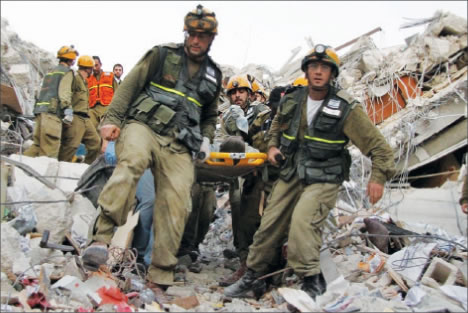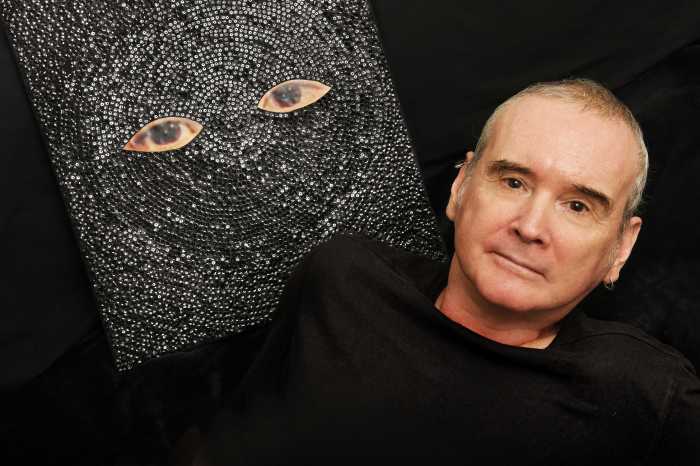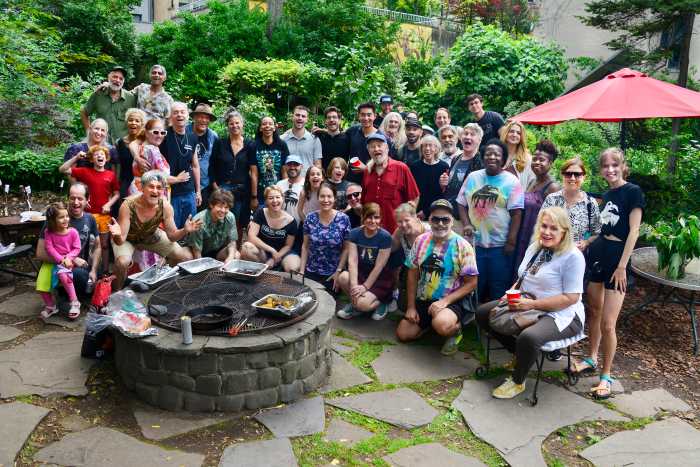By Tequila Minsky
Soho resident and Villager photographer Tequila Minsky was already in Port-au-Prince, Haiti, when the Jan. 12 earthquake struck. A lover of Haitian culture, Minsky was visiting with a delegation of 10 New Yorkers interested in learning about Mouvman Peyisan Papaye (Peasant Movement of Papaye). Minsky was acting as the group’s liaison, since she had previously visited the organization. As Minsky explained it, M.P.P. is “the second-oldest peasant organization in the Americas. It supports the work of peasants and small farmers, and believes in agricultural self-sufficiency. It is based in the Plateau Central, the center of the country, and nationally has 200,000 members. Some of our delegation had plans to stay a few days more — I, weeks more, with projects planned.” As Minsky and the others were getting settled at the Hotel Oloffson, about three hours after their arrival, she said, “The walls of the hotel began to shake.” … Minsky sent the following dispatch to The Villager Monday morning.
“Have you ever experienced something like this?” an American priest from the Dominican Republic — who works with Haitians — asked me Saturday at the funeral of the archbishop of Port-au-Prince.
It’s been such a whirl of events that I took pause to think and not just react, maybe for the first time since the earthquake.
“Yes, I have,” I said. “I’m from New York and we had 9/11.”
After some thought, the priest nodded in understanding. And this catastrophe feels like that. It’s the turning upside down of the world, as you know it — how in one moment everyone’s life changes. The amount of devastation was not grasped at first.
Like the tale of the blind men and the elephant, with communications minimal, phones out — though the Internet and Skype worked — minutes after it happened, one could see only what was around, lots of dust in the street, some injuries, some houses and schools damaged.
As time passed, in the hours afterward, news trickled into the Hotel Oloffson, where I had the great luck to be staying in Port-au-Prince when the earthquake hit. Walls swayed a bit and pictures were tossed off of walls. I was thinking, “Oh, is this what they mean when they say it’s an earthquake?” This late-19th-century wooden, gingerbread house maintained its dignity and, more important, its structure. Meanwhile, a shell of an abandoned, eight-floor, concrete hotel from the ’50s — the first to be built with an elevator, just above this aged, yet flexible structure — folded into itself floor upon floor.
Later that evening, we learned of the government buildings, including Haiti’s version of the White House, its National Palace, down. We also learned though the Internet that the hotel where many foreigners go, the Hotel Montana, down. The headquarters of the U.N., down. In the hours after the earthquake the proprietor of the Oloffson kept everyone informed via Twitter; Larry King quoted him. He continues every night to tweet.
The next few days we learned what all that meant and more — the devastation that crumbled some buildings, while others (probably built to more exacting standards) stood. Among these latter survivors was the two-year-old, 12-story building by Digicel, the new cell company that broke a communications monopoly in this country.
LEFT: A young boy was pulled out alive from the rubble on the third day after the quake near the cathedral in Port-au-Prince’s Bel Aire district. He was taken to a makeshift triage center and treated by Cuban doctors. RIGHT: A woman receiving treatment at the Israeli field hospital.
So many were lost
And we learned of countable tragedies among the countless. Three major women leaders — working on behalf of the beleaguered women of Haiti — in their own or others’ homes when the quake hit, perished. At the Hotel Montana, a foreign couple and their two newly adopted Haitian children, gone. As were four men, part of an eight-person team to restart a development program from the Methodist development organization UMCOR, gone. (The women on their team stayed at the Methodist guesthouse and are all right.) Also lost along with the foreigner guests were the Montana’s Haitian waiters and other staff.
The head of the U.N. in Haiti and 200 died at their headquarters. One hundred thirty nursing students in class, the young girls’ bodies pulled out the following day. The parents of the minister of Tourism, also lost. A renowned Haitian living in Montreal, active in the exile community opposing Duvalier, a geography professor, along with his wife, who were visiting his homeland, dead. A young American man working in an orphanage. …
The named, the unnamed. Those buried in mass graves. Bodies burned in lieu of disposal. There are still bodies in buildings; you can smell them as you walk or drive by. Yesterday, I saw two bodies on the street, and today, the desiccated remains of one in a building, and the burned remains of a skeleton on a street. The loss of life is beyond comprehension. Sunday’s confirmed estimate is 111,481 dead in four regions.
Rescue teams arrive
Rescue teams came from around the world. Iceland was the first, followed by 120 B-FAST (Belgian First Aid and Support Team) search-and-rescuers, who hit the ground running along with their sniffer dogs — off into the neighborhoods, finding those still alive. On that first night after, just down the road from the Oloffson Hotel, they found two alive from a collapsed new multistory office building. With no more sign from the dogs, they left even after the pleading of a brother who begged them to continue. They were there to find the living. More teams came, a global influx of rescuers, from China, Qatar, South Africa, Colombia and all places in between. They camped out in compounds at a U.N. base camp attached to the one runway at the airport. There were also teams from Florida and the highly experienced New York City firefighters and police, all 9/11 veterans. I spoke to one who told me of what a positive experience he was having and how grateful the Haitians were; his eyes were a bit more open to the Haitian reality, not filtered through a condensed media portrayal. He was experiencing Haitian humanity. On the third day, a young boy was pulled out and treated at a triage center headed up by Cuban doctors. This center was later joined by other international medical teams; by Sunday, a tent with 20 beds filled, offered some shelter in the courtyard for the recovering.
The Israelis came with a rescue team and a field hospital — 200 personnel. Supplies were in the air three days after the quake when they let the U.N. know that they were on their way and needed a location to set up. There was much confusion. An Egyptian-Jewish Haitian businessman and honorary Israeli consul of Haiti offered the sports field on his humungous factory works property to house the Israeli camp. The businessman provided the trucks to unload the tents, medical equipment, communication hardware and all supplies. Though promised, no logistical help whatsoever came from either the U.N. or the government. The Israeli team arrived at 4 a.m., and in eight hours, the field hospital was set up; along with rescues, they saw 100 patients the first day. This field hospital became a model. Surgeries, births, broken bones and trauma were treated. The first baby born there was named Israel Michel.
Finally, hospital ship helps
Days later, the U.S. Navy hospital ship Comfort moored in the waters of Port-au-Prince bay began to take in the absolutely most-critical patients by helicopter. A boy hit by a car left the Israeli field hospital for the Comfort.
At the polar opposite, a small nonprofit Israeli team, a doctor, social worker and two others, provided medical and psychosocial care in a makeshift clinic between Port-au-Prince and the hilly suburb of Pétionville. They worked alongside a young Dominican doctor and a German nurse living in Haiti for decades. A young Israeli girl sang songs and played card games with the displaced children. Meanwhile, a long line snaked uphill, waiting. At two points in this line, a well-organized French aid organization — without any armed security — finally distributed boxes of emergency biscuits and a high-energy gruel to almost 5,000 internally displaced residents living in three makeshift tented compounds.
On Friday, it turned out that a friend needed some advanced medical evaluation and the small Israeli team, with their hosts — an Israeli/Palestinian/Haitian couple — insisted on taking her to the Israeli field hospital. As my friend was tested, the small team took a tour. I met a man rescued that day, 10 days trapped.
Shabbat with medics
We were invited for a Shabbat dinner at the Israeli field hospital, what a privilege. Among the 200 army members, doctors, nurses and support staff were other aid groups. Haitian translators and guests ate the selection of Mediterranean tapas — garbanzo beans, grape leaves, salad and rice, followed by meatballs — and some red wine. Before having a Shabbat prayer, the evening started off with heartfelt kudos by the V.I.P.’s on the success of this mission.
Words in Hebrew came from the general in charge, in English from the Israeli ambassador to the Caribbean stationed in the Dominican Republic and from the businessman, now named vice consul, who made it happen.
The field hospital disassembles this week; they’re leaving on Thursday — having been on the ground for two weeks. I was told, “Many others are coming now. They’re building a 700-bed hospital [University of Miami] at the airport. We’ve been here two weeks. People have to get back to their families. We accomplished what we came for.” The Israelis provided a model field hospital, and by the time they leave will have treated more than 1,000 Haitians. They brought the first well-equipped field hospital — with an X-ray tent, a pediatric tent and three incubators for preemies.
In the tent cities
As for those left living, there are many without shelter — either their houses are completely demolished or just plain structurally unsound. Immediately after the earthquake, tent cities sprang up. Belongings were salvaged carefully and placed on a piece of turf that could be in the middle of the street, or in Haiti’s version of Central Park, Champs de Mars, in a house or apartment courtyard, in a parking area, a soccer field, on a street median. With luck, an institution looks on and helps out. The count is almost 500 of these tent cities of internally displaced residents. Most of these are constructed from sheets and bedspreads. There are no sanitation facilities. The Haitian Interior Ministry said that about 610,000 people have been left homeless.
Incredibly, the activities of everyday life — cooking and washing — began almost immediately, even in the tent cities. With help being so slow to arrive, people couldn’t wait. In a semblance of normalcy, oddly days later, fresh produce — pineapple and grapefruit — could be seen on the street, along with some vegetables from the cool mountains, sold by market women on the street. The problem is people don’t have cash; they’ve lost everything, and many, their livelihoods.
Now, water bladders filled and connected to taps provide for those in the Champs de Mars, and there is a food distribution of rice and beans there in the afternoon. Smaller encampments may not have received anything yet. Aid has been incredibly slow to get out, and there has been seemingly almost no presence of official leadership. Nongovernmental organizations (N.G.O.’s) are working in and providing for the tent cities. In the absence of leadership, the indomitable resilience of the Haitian people is evident.
It is said food aid will be needed for months. Tents will be needed before the rains come and permanent housing is built. Most of the schools have been destroyed.
Many people have fled by bus or boat, or by truck for those who could pack a truck full of household items, to their ancestral towns in the provinces. The government is encouraging those with family in unaffected regions of the country to leave Port-au-Prince.
A chance to rebuild
Now is a chance to encourage and support life in the small and large cities throughout the country and reverse the flow to the capital that made it so unlivable — that saw its population grow from 400,000 to almost 3 million. The longer-term needs merge with those needs the country had before all this happened: universal education, economic development and environmental attention and decentralization.
For now, it’s the immediate needs that must be addressed: providing shelter before the rains, sustenance to the population, continued care of the injured and then the education of the children.






































